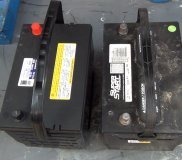If the battery is still good, it simply needs to be charged at a slow rate for a couple of hours. A jump-start will get it going too, but expect to need to leave the cables connected for a good five to ten minutes before you try to start the engine. When a battery is nearly fully-discharged, it can take up to 15 minutes for the acid in the battery to become conductive enough for it to even start to take a charge. Until then, it is asking too much of the jumper cables to let enough current through to crank the engine.
For a car as new as yours, unless stated otherwise by the manufacturer, the industry standard is a maximum of 35 milliamps, (.035 amps), drain to maintain the memories in the multiple computers. At that rate, a good, fully-charged battery will still be strong enough to crank the engine fast enough to start after sitting for three weeks. Most will go a little longer than three weeks, but rarely three months.
Take a peek at this article first:
https://www.2carpros.com/articles/how-to-jump-start-car-battery-using-jumper-cables
then check out this video:
https://youtu.be/a9Ycibu9cwY
The biggest problem people cause is damage to the electrical system when the cables are connected improperly. At a minimum there will be multiple blown fuses. Computers are designed to cause fuses to blow before the reversed jumper cables can damage them.
Before you connect the jumper cables, you can identify the positive and negative battery posts in multiple ways. The positive post is always slightly larger in diameter, but that can be hard to see by just looking at them. There will be plus and minus signs next to each post, and in a few cases you'll find red paint on top of the positive post and green paint on the negative post.. If you still aren't sure, follow the cables to see where they go. From the positive post, there will be a second, smaller-diameter wire that connects to the under-hood fuse box. From the negative post, the smaller wire will bolt to the body sheet metal and the larger cable will bolt to the engine or transmission.
Always start by connecting one of the jumper cables to the positive post on each battery. Next, connect one end of the other jumper cable to the negative post on one of the batteries, then connect the other end of that cable to a clean, paint-free point on the engine of the second car. It will work if that last connection is made to the second battery's negative post. The reason we go to the engine instead is when the last of the four connections is made, there are going to be some small sparks. All batteries give off explosive hydrogen gas, and we want those sparks to be as far away from that as possible. You rarely hear of a battery exploding because we follow these procedures.
Likewise, when you remove the jumper cables, always disconnect the one on the engine first. There could be some harmless sparks created there, and again, they won't be near the battery. Once that end is disconnected, no sparks can occur at any of the other three connections when you take them off.
Once the engine is running, it will take up to perhaps 20 minutes for it to recharge enough that it will crank the engine for restarting later. Generators on cars do that at a controlled, but very steady rate which batteries are designed for. Home battery chargers develop a strong pulsing current to get the job done. That pulsing vibrates the plates inside the battery, and on older ones, that accelerates how fast the lead flakes off those plates. Charging at a slow rate or with a very small battery charger lessens how fast that flaking occurs and will reduce the life-shortening effects of charging the battery that way. This is less important for relatively new batteries of around two years old or less.
Once most batteries get to be close to five years old, enough lead has flaked off the plates and collected at the bottom of the case to where it builds up, then shorts those plates together. At that point that cell is shorted and the battery has to be replaced. If you run into that, you can check out these articles and videos, then do the job yourself:
https://www.2carpros.com/articles/how-to-replace-a-car-battery
https://youtu.be/oQrfCZy5nJg
SPONSORED LINKS
Wednesday, March 24th, 2021 AT 6:52 PM




